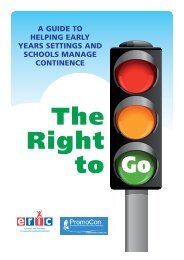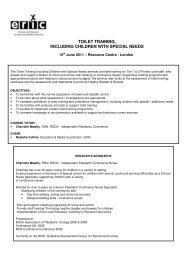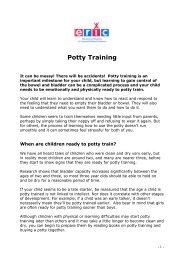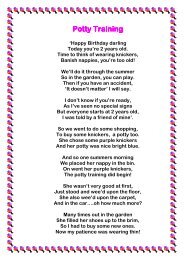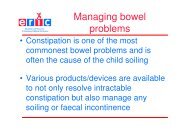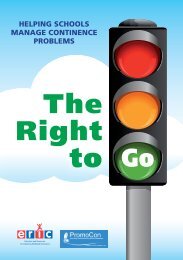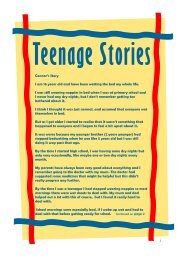A to Z of Potty Training Tips - Eric
A to Z of Potty Training Tips - Eric
A to Z of Potty Training Tips - Eric
Create successful ePaper yourself
Turn your PDF publications into a flip-book with our unique Google optimized e-Paper software.
A <strong>to</strong> Z <strong>of</strong> <strong>Potty</strong> <strong>Training</strong> <strong>Tips</strong><br />
Age<br />
There is no right age <strong>to</strong> potty train, as natural readiness varies from child <strong>to</strong> child.<br />
Children gain bowel and bladder control at their own pace, but most are potty<br />
trained somewhere between the ages <strong>of</strong> 2 and 3 years, for others it can take a<br />
little longer.<br />
Be positive<br />
Be very positive about every step your child makes during the potty training<br />
process – reward him for bringing his potty in<strong>to</strong> the room, or sitting on it. Don’t<br />
worry about whether or not he’s performing on it initially. This will come in time.<br />
You just want him <strong>to</strong> be relaxed around the potty and happy <strong>to</strong> sit on it <strong>to</strong> begin<br />
with.<br />
Consistent<br />
You will be disappointed if you try <strong>to</strong> potty train in just one day; it can take half a<br />
day <strong>to</strong> simply introduce your child <strong>to</strong> the potty, but it will take much longer for<br />
significant progress <strong>to</strong> be made and for your child <strong>to</strong> use the potty without help.<br />
Of course, you still have a busy life <strong>to</strong> lead, but it is important <strong>to</strong> be consistent and<br />
ensure you have the time and flexibility <strong>to</strong> concentrate on potty training.<br />
Drinking<br />
Encourage your child <strong>to</strong> drink six <strong>to</strong> eight cups <strong>of</strong> drink (water based drinks are<br />
best) spread over a day.
Encourage<br />
Encourage your child <strong>to</strong> sit on the potty is a short while after a drink. Try <strong>to</strong> sit<br />
him on the potty every couple <strong>of</strong> hours but don’t keep him sitting there for more<br />
than a couple <strong>of</strong> minutes each time. If he asks for the potty in-between then<br />
that’s great. If your child has a regular pattern for pooing, try sitting him on the<br />
potty <strong>to</strong> coincide with his natural rhythm.<br />
Friends and family<br />
It’s <strong>of</strong>ten the case that friends will tell you their child was dry at an early age, or<br />
for your family <strong>to</strong> encourage you <strong>to</strong> get on with potty training. It’s best <strong>to</strong> resist<br />
these pressures and <strong>to</strong> wait until your child shows signs <strong>of</strong> readiness before<br />
starting potty training. <strong>Potty</strong> training is a miles<strong>to</strong>ne like any other in a child’s<br />
development and each child is unique, they will be ready in their own time.<br />
Gentle reminders and prompts<br />
Children enjoy being praised when they sit on the potty whether or not they have<br />
managed <strong>to</strong> have a wee or poo in it. When they do finally have a wee or poo it’s<br />
<strong>of</strong>ten cause for great celebration and children enjoy the praise and fuss<br />
surrounding each success. You’ll need <strong>to</strong> continue giving gentle reminders and<br />
prompts until your child is reliably dry and independent. For an added incentive <strong>to</strong><br />
use the potty you may wish <strong>to</strong> consider buying a musical potty which is activated<br />
when a child wees – the insert available from ERIC has the added bonus <strong>of</strong> playing<br />
a variety <strong>of</strong> tunes or you can record a message.<br />
Help your child feel proud<br />
When the inevitable accidents occur, try <strong>to</strong> simply clean up and change pants<br />
without any fuss. Give lots <strong>of</strong> praise at each success on the potty so that your<br />
child feels proud <strong>of</strong> himself and his achievements.<br />
Independence<br />
As children become more independent and the focus goes <strong>of</strong>f potty training, it can<br />
sometimes seem they take a backwards step and start having occasional accidents<br />
again. Many children become so involved in play that they can simply forget about<br />
using the potty; continue giving gentle reminders and prompts at these times and<br />
with a little gentle persuasion they will soon overcome this hurdle.
Just before starting <strong>to</strong> potty train<br />
Before you start <strong>to</strong> potty train your child, talk <strong>to</strong> him about what you are going <strong>to</strong><br />
do and make a special trip with him <strong>to</strong> buy a potty and pants. Now is a good time<br />
<strong>to</strong> get some picture books about potty training and read them <strong>to</strong>gether (available<br />
from ERIC). Decide what you’re going <strong>to</strong> call wee and poo and let everyone<br />
involved in your child’s care know that you are potty training so that there is a<br />
consistent approach.<br />
Keeping focused<br />
Some children seem <strong>to</strong> potty train with great ease, but others can take a while <strong>to</strong><br />
master all the skills needed <strong>to</strong> gain bladder and bowel control. Like any stage <strong>of</strong> a<br />
child’s development, bladder and bowel control is achieved at the child’s own pace.<br />
If a child starts potty training before he is ready then it is inevitable that he will<br />
take longer <strong>to</strong> potty train than a child who is showing signs <strong>of</strong> readiness. If you<br />
feel your child is not quite ready, simply delay potty training for a few weeks and<br />
then try again – it may go more smoothly the next time.<br />
Loss <strong>of</strong> interest<br />
If your child seems <strong>to</strong> have lost interest in potty training you could try inspiring<br />
him afresh. Perhaps taking him <strong>to</strong> choose a new potty, or letting him put reward<br />
stickers on<strong>to</strong> the potty each time he sits on it. Ensure your child continues <strong>to</strong><br />
receive lots <strong>of</strong> praise for using the potty and think <strong>of</strong> ways <strong>to</strong> change the routine<br />
so he is more focussed on using it.<br />
Moving on <strong>to</strong> the <strong>to</strong>ilet<br />
Using a potty is the best was <strong>to</strong> start for most children as it is easy <strong>to</strong> get on and<br />
<strong>of</strong>f and can be moved around. The eventual aim <strong>of</strong> potty training will be for your<br />
child <strong>to</strong> use the <strong>to</strong>ilet. For many children there is a natural progression <strong>to</strong> using<br />
the <strong>to</strong>ilet, but for others it may take a while <strong>to</strong> progress.<br />
You will need a step high enough <strong>to</strong> help your child get up <strong>to</strong> the <strong>to</strong>ilet and <strong>to</strong> rest<br />
their feet on when sitting on the <strong>to</strong>ilet - this is especially important for pooing. A
child’s <strong>to</strong>ilet seat that fits inside the usual <strong>to</strong>ilet seat can be useful <strong>to</strong> help your<br />
child <strong>to</strong> feel secure.<br />
Boys will <strong>of</strong>ten wish <strong>to</strong> copy their dads or older brothers and wee standing up. It’s<br />
inevitable this will result in spraying around the <strong>to</strong>ilet and you may choose <strong>to</strong><br />
minimise the mess by adding some <strong>to</strong>ilet balls <strong>to</strong> improve aim in the <strong>to</strong>ilet. When<br />
boys do start standing <strong>to</strong> wee, it is important <strong>to</strong> ensure they have a daily routine<br />
for sitting on the <strong>to</strong>ilet for a poo. If time <strong>to</strong> poo is not included in the daily routine<br />
it can get forgotten and can lead <strong>to</strong> constipation.<br />
Nursery<br />
Take time <strong>to</strong> let your all child’s carers know that you have started <strong>to</strong> potty train –<br />
this will ensure consistency in your approaches. If your child goes <strong>to</strong> nursery, see<br />
what potty the nursery uses – it may help if you get the same one for home, so it<br />
looks familiar. You may choose <strong>to</strong> discus potty training with your nursery before<br />
starting so they can help your child be prepared.<br />
Overcoming the need for a nappy <strong>to</strong> have a poo<br />
It isn’t unusual for a child <strong>to</strong> ask for a nappy when wants he wants a poo; it’s a<br />
common request at this stage. But, don’t despair; this is a good time <strong>to</strong> properly<br />
address it.<br />
Some children will simply accept that there are no more nappies, but for others<br />
you will need <strong>to</strong> find ways <strong>to</strong> encourage sitting and pooing on the potty. Many<br />
children will have a regular pattern <strong>to</strong> their pooing; if this is the case encourage<br />
your child <strong>to</strong> sit on the potty at their usual poo time.<br />
Other children will wriggle around and some will simply ask for the nappy when<br />
they know they need a poo – try <strong>to</strong> encourage them <strong>to</strong> sit on the potty, before<br />
putting on the nappy.<br />
If these suggestions don’t work, ensure the nappies are kept and used in the <strong>to</strong>ilet<br />
area; try sitting your child on the potty with his nappy on and when he is happy <strong>to</strong>
poo this way, you can see if he’ll let you take the nappy <strong>of</strong>f. If he is reluctant <strong>to</strong><br />
remove it, you could make a hole in the back <strong>of</strong> the nappy so the poo can drop<br />
through. Once achieved, a poo in the potty is a time <strong>of</strong> celebration, with plenty <strong>of</strong><br />
praise and a wave goodbye <strong>to</strong> poo as it is emptied down the <strong>to</strong>ilet on its way “pooland”!<br />
<strong>Potty</strong> plans<br />
Letting you child help choose a potty is a good idea. Talk about it, plan a trip <strong>to</strong><br />
the shops – and make it a special adventure for the two <strong>of</strong> you. Make sure the<br />
potty is comfortable, has a good base and won’t tip.<br />
You may wish <strong>to</strong> consider buying a musical potty insert which is activated when a<br />
child wees – the one available from ERIC has the added bonus <strong>of</strong> playing a number<br />
<strong>of</strong> tunes or a recorded message. Plan where you’re going <strong>to</strong> put the potty in<br />
advance, keep it in the same room, and if possible, in the same place so it’s easy<br />
<strong>to</strong> find.<br />
Your child will feel more secure about the potty if he knows where it is. Whatever<br />
room you choose for the potty, put some <strong>to</strong>ys and books in there and keep the<br />
environment pleasant, and relaxed.<br />
Questions?<br />
If you have any questions about potty training, just ask ERIC. The ERIC Helpline<br />
is available weekdays between 10am-4pm on 0845 370 8008.<br />
Reading the signs<br />
Is your child able <strong>to</strong> stay dry in his nappy for 1½ <strong>to</strong> 2 hours? Is he excited at<br />
seeing his wee make a fountain when having a bath? Is he keen <strong>to</strong> have his<br />
nappy <strong>of</strong>f and wear pants like a big boy? Does he wiggle around when he needs a<br />
poo or wee? Is he interested in what you do on the <strong>to</strong>ilet? All <strong>of</strong> these are signs <strong>of</strong><br />
readiness <strong>to</strong> be potty trained. Now it’s also good time <strong>to</strong> get some picture books<br />
about potty training and read them <strong>to</strong>gether (available from ERIC).
Signs <strong>of</strong> readiness include managing <strong>to</strong> stay dry for 1½ - 2 hours between each<br />
wee; showing awareness <strong>of</strong> weeing or pooing by perhaps s<strong>to</strong>pping and<br />
concentrating or telling you what they are doing; having developed the ability <strong>to</strong><br />
understand and respond <strong>to</strong> simple instructions such as ‘do you need a wee?’ or<br />
‘find your potty’ and <strong>to</strong> get on and <strong>of</strong>f the potty with only a little help.<br />
Try <strong>to</strong> avoid potty training if your <strong>to</strong>ddler is going through a resistant ‘no’ stage:<br />
it’ll be easier if your child enjoys praise and shows a desire <strong>to</strong> please and<br />
cooperate.<br />
Stay positive<br />
There will be accidents, be prepared for regular pant changing during the early<br />
stages <strong>of</strong> potty training. If you remain calm and make potty training fun and give<br />
lots <strong>of</strong> praise and encouragement, potty training is likely <strong>to</strong> be a positive<br />
experience for both <strong>of</strong> you.<br />
Time <strong>to</strong> share<br />
If your child gets up and runs away from the potty each time you sit him on it,<br />
stay calm. Try <strong>to</strong> make the time he sits on the potty a special time, just for the<br />
two <strong>of</strong> you. You can sing a favourite rhyme, or read a book <strong>to</strong>gether. Always be<br />
positive when you talk about the potty.<br />
Up, up and away<br />
It’s inevitable that you will not be able <strong>to</strong> stay indoors the whole time you are<br />
potty training and at some time you will need <strong>to</strong> venture out without the safety <strong>of</strong><br />
a nappy on your child. When you are out and about you may choose <strong>to</strong> use<br />
washable training pants (available from ERIC), disposable training pants, or<br />
perhaps simply use ordinary cot<strong>to</strong>n pants. It is important <strong>to</strong> continue <strong>to</strong> take your<br />
child <strong>to</strong> the <strong>to</strong>ilet when out and about even with training pants on. You may<br />
consider carrying a collapsible portable potty as they are discreet and easy <strong>to</strong><br />
carry.
Visiting the shops<br />
Make a special visit <strong>to</strong> the shops and let your child choose his own set <strong>of</strong> pants,<br />
perhaps with a TV or car<strong>to</strong>on character on it. If he feels proud <strong>of</strong> his new big boy<br />
pants, he will be keen <strong>to</strong> keep them clean and dry. If you chose <strong>to</strong> use pull ups in<br />
the early days when you are out and about you could try putting his cot<strong>to</strong>n pants<br />
on underneath so that if your child starts <strong>to</strong> wee, he’ll feel wet and be more aware.<br />
Wiping<br />
It will be a while before your child will be able <strong>to</strong> wipe his bum independently after<br />
a poo. It is a complicated process and very young children haven’t yet mastered<br />
the coordination skills. You can start <strong>to</strong> develop the skills needed for wiping by<br />
letting your child attempt <strong>to</strong> wipe after you have cleaned him up. Don’t forget <strong>to</strong><br />
wash his hands. Girls should always wipe from front <strong>to</strong> back.<br />
Xtra fun<br />
When boys start <strong>to</strong> stand at the <strong>to</strong>ilet <strong>to</strong> wee, it can take a while for them <strong>to</strong><br />
perfect their aim in<strong>to</strong> the <strong>to</strong>ilet. It can help a boy’s aim as well as be fun, <strong>to</strong> put<br />
table tennis balls or <strong>to</strong>ilet balls (available form ERIC) in the water <strong>to</strong> aim at.<br />
You two<br />
Make sure potty training is a fun and relaxed time for both <strong>of</strong> you. There will be<br />
accidents, but be patient – go at your child’s own pace. For some children, potty<br />
training happens quickly and smoothly, but for others it can take a while. If you<br />
feel things are not progressing you may choose <strong>to</strong> put the nappies back on and try<br />
again in a few weeks when your child is ready.<br />
Zips and but<strong>to</strong>ns<br />
Avoid clothes that are difficult for you or your child <strong>to</strong> remove in a hurry such as<br />
dungarees or trousers with zips and but<strong>to</strong>ns. You need clothes that are easy <strong>to</strong><br />
pull down quickly. Your child will also eventually need <strong>to</strong> be able <strong>to</strong> pull his own<br />
trousers down – so the easier, the better.
© ERIC 2010






